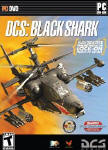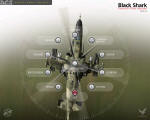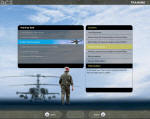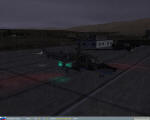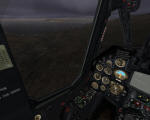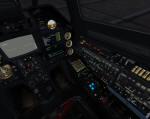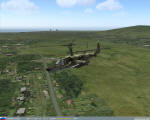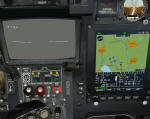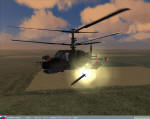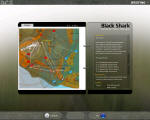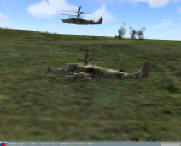|
KA-50
Black Shark |
||||
|
AT LAST; A NEW HELOSIM
And before I go any further let’s talk about DRM. Yes, my download version of Black Shark is protected by Starforce. It is an online activation system that does not install any “protection” drivers. You get eight activations and ten deactivations in the English version. The protection scheme is very well documented in the Quick Start Guide with over 20 pages being devoted to explaining how it works. It has yet to cause me any problems. The documentation and training missions that comes with Black Shark is more than sufficient. A 162 page user interface manual, a 56 page quick start manual, and a 383 page flight manual is included in PDF format. Also, you have a total of 22 narrated (by Matt Wagner himself) training missions that demonstrate for you what to do and then turn the helicopter over to the player’s control to do it. These training missions cover overviews, basic flight, advanced flight, weapons, and navigation. Black Shark includes all the tools needed to get a green helicopter simmer up to speed. I am primarily a fixed wing flight simmer except for two notable exceptions. One being me becoming enamored with the whirly birds in FS9 and flying almost strictly helicopters for a few months, and again when I finally was able to configure Jane’s Longbow 2 to run well on a Glide emulator. And let me tell you, I played the snot out of Longbow 2 for the better part of a year. So the obvious question for fans of the hardcore combat helo sim is does Black Shark measure up to its illustrious predecessor? There is no denying that Black Shark is pretty to look at, and great to listen to. As one would expect from a descendant of Lock On, the eye candy is above and beyond what most simmers require. The level of detail of the units and terrain is amazing. As far as I can tell from Google Earth, the developers have very accurately depicted the region of the Caucasus and southern Russia that Black Shark plays out in. Two important items for helicopter pilots are there in Black Shark : trees and infantry. I can find nothing to complain about graphically in Black Shark other than the fact that many with older systems will have trouble running it. I run it with all my settings on medium, except visibility which is set to high. Every now and again there is a stutter, but it otherwise runs smoothly on my system. The in game audio is good and definitely contributes to the sense of immersion in Black Shark. Both the in game graphics and audio are good, and graphics are outright be the best I have seen in a modern combat flight simulation.
Black Shark possesses some of, if not the best flight dynamics modeling I’ve ever seen. I of course have to make the disclaimer that I’ve never flow a helicopter, and certainly not a KA-50. But I have flown small aircraft before and the feeling of flight is there in Black Shark. Everything feels right, and is very well modeled as far as I can tell. You will need at the very least a few days to become a passable KA-50 pilot, and weeks more to become a good one. Kamov in fact supported the development of Black Shark, and real KA-50 pilots have approved of the flight model. My one complaint is that the trimming system can be awkward (though still perfectly flyable) for those without a Force Feedback joystick. This is expected to be resolved in the first patch, due out in April. That minor irritant is the only bad thing I can find to say about Black Shark’s flight modeling. Non combat systems simulation is done very well in Black Shark. Startup procedures are modeled just as good if not better than any sim I have ever seen, even to the extent that you must call your crew chief to connect ground power before you flip the switches in the cockpit. It should be noted that it is up to the mission designer to decide whether you start “cold and dark” in the cockpit or engines running and that there is also a one keystroke auto start option available. Also, in localized versions the labeling of the cockpit is such that you don’t have to learn Russian. My Black Shark cockpit is labeled in English, thank goodness. Systems like hydraulics and electrics are actually modeled, there is no scripting here as far as I can tell. The simulation of the ABRIS (acronym for advanced moving map system in Russian) moving map and PVI-800 inertial navigation system is very in depth. You could easily spend a week learning every single function of these two systems if you had the inclination.
Black Shark cockpit looking right. And looking left with an airfield in sight. Just flying the Black Shark
around without blowing stuff up is a fully engaging task. You have to fly the
helicopter, either by hand or setting the autopilot to do it for you. Avoiding
terrain, building, and power lines is generally always a factor during low
level flight to and from a target area. On longer flights it is necessary to
update the INU (inertial navigation unit) position due to gyro drift. The
dynamic and realistic modeling of flight performance and systems and how they
react to environmental variables is one of Black Shark’s greatest
achievements. Thinking like a pilot is not optional in this title that so
deserves the label – “simulation”. You absolutely have to be focused and one
step ahead of your machine. Or you could
ABRIS while en route to target practice. Locking up a target with the Shkval. Vikhr away! The artificial intelligence in the sim is about what one can expect from artificial intelligence. The friendly artificial intelligence is good enough where they are not your worst enemy. They can be frustrating at times, most commonly what I’ve seen is they will wonder out a bit farther than I intend them to when I send them forward to engage and eat a MANPADS rather than hanging back out. As long as you keep them on a tight leash you should find them a help all in all though. The enemy AI is competent enough to make the modern battle field a very dangerous place for your KA-50 (as it should be). Enemy ground units do not hesitate to engage you with air defense weapons, their main gun tubes, vehicle mounted MGs, ATGMS, and so on. Come close enough and they will do everything they can to try and kill you. Enemy helicopters are twice as much of a pain because of their generally superior sensor fit and ability to hunt you down. You’d better be ready to move fast when your laser warning system lights up. Black Shark comes with a dozen or so single missions and two linked campaigns. The single missions offer a representative set of KA-50 missions, as well as a few showcasing some piloting challenges (night, bad weather, high altitude). There are two campaigns. The first, titled “Deployment” begins with counter insurgency operations that transition to a full on war between Georgia and NATO. The second campaign, “Georgian Oil War”, is a monster that can be played as a single grand campaign or in three separate parts. The “Oil War” is a full on Russia-Georgia war that eventually involves NATO as well. I’ve played about two dozen missions in total from both campaigns and they strike me as well designed, and “Oil War” is particularly challenging. Some may complain about the lack of a dynamic campaign, but as someone who enjoyed Jane’s F/A-18 for many years I find that well designed linked missions with random elements can be just as entertaining. While both campaigns have an excellent battlefield immersion factor (watching the two sides duke it out and seeing the battlefield get littered with burning vehicles is just cool), the lack of radio chatter beyond your own flight is disappointing. There are plenty of quality missions to fly that ship with the game, and once the community starts pumping them out helo simmers will be busy for quite a while.
Although I’ve never played multiplayer, it is an option with Black Shark. You may have noticed that there was no multiplayer option in the main Black Shark menu; multiplayer is started with a separate executable file. Both head to head and cooperative is possible through an IP or LAN connection I would think that a cooperative mission with each player doing to his part to recon and data link targets would be a blast. There is amazing multiplayer potential in the DCS series if in the future each module is multiplayer compatible with all the previous releases. I think it should be clear by now that overall, I like Black Shark. A lot. There are a few minor issues around, but they are just that to me – a few minor issues. The bad points like the DRM scheme, lack of a dynamic campaign, and other little issues are something most will probably never notice. I am quite pleased to see that version 1.00 of Black Shark is as polished and well done as it is. It’s safe to say that Black Shark is the new king of combat helo sims, and I can’t wait to see what will come out of the DCS series in the future. HeloSim's Rating - 9 out of 10
Developer: Eagle Dynamics Other stuff: Matt Wagner’s producer’s notes on YouTube are an excellent system by system “show and tell” on Black Shark Keep in mind I run Black Shark
on MEDIUM settings in the interest of framerate. Reviewer’s specs: Windows
Vista 64 Bit Home Ultimate Recommended specs: OS: Windows Vista for launching in fullscreen mode; CPU: Intel Core 2 Duo E6850+, AMD Phenom 9850+; RAM: 2+ GB; Graphics: 512+ MB ATI HD 2900+ or nVidia 8800+; Sound card; 4+ GB of free space on HDD; Copy protected, requires internet activation; Joystick.
|
||||
Helosim.com
